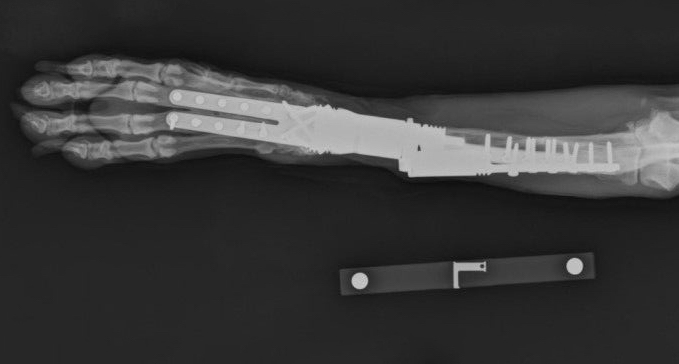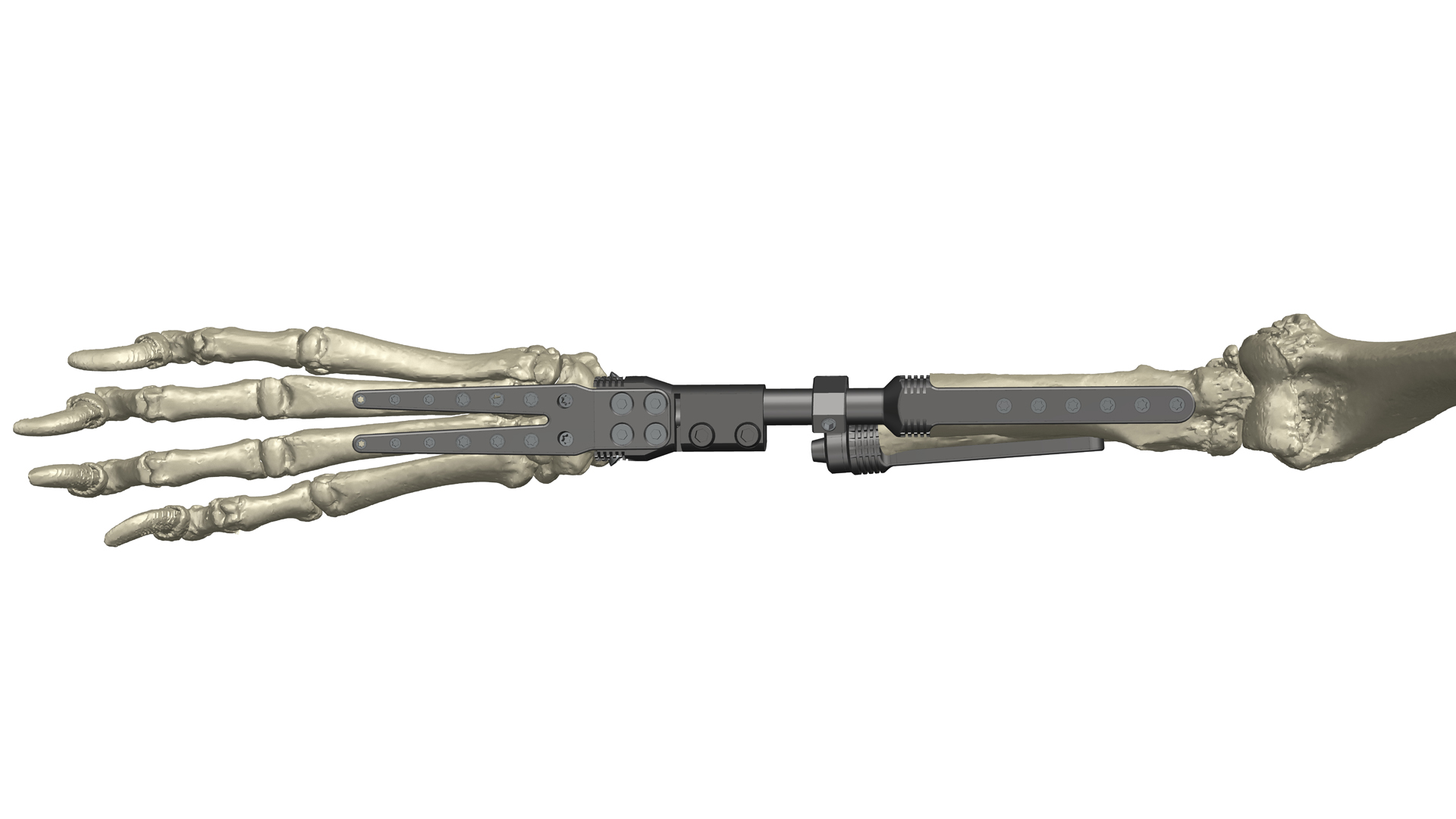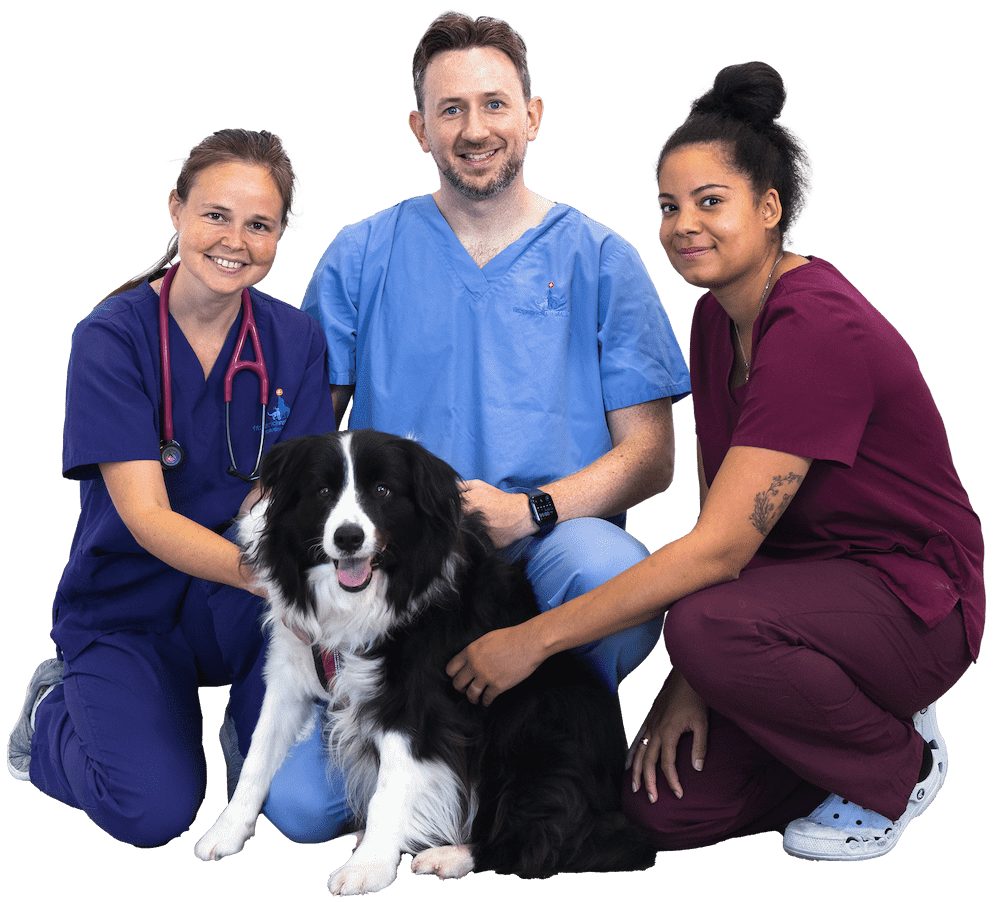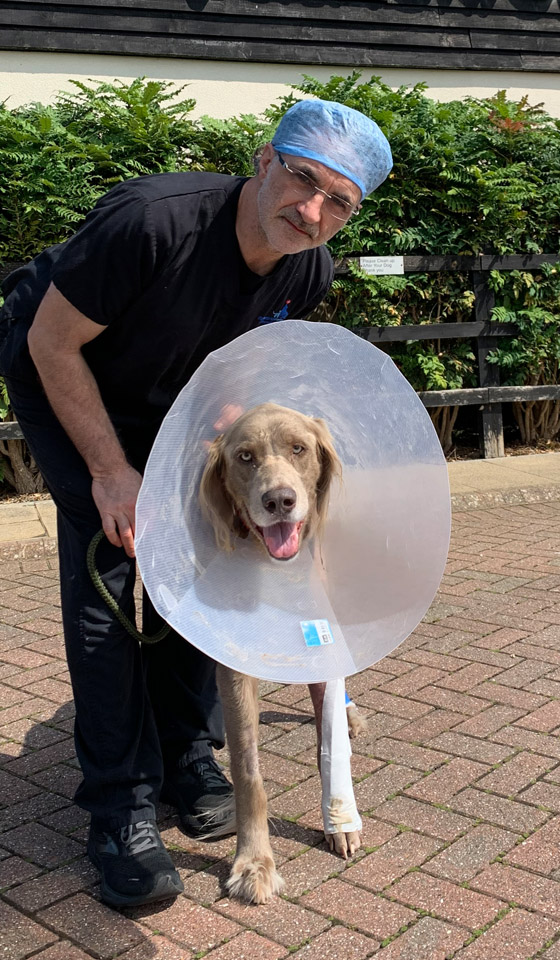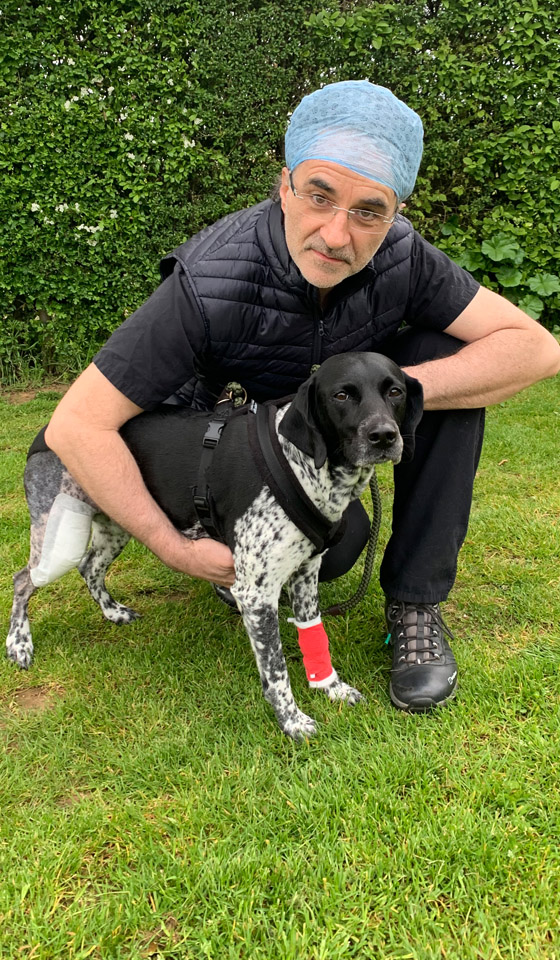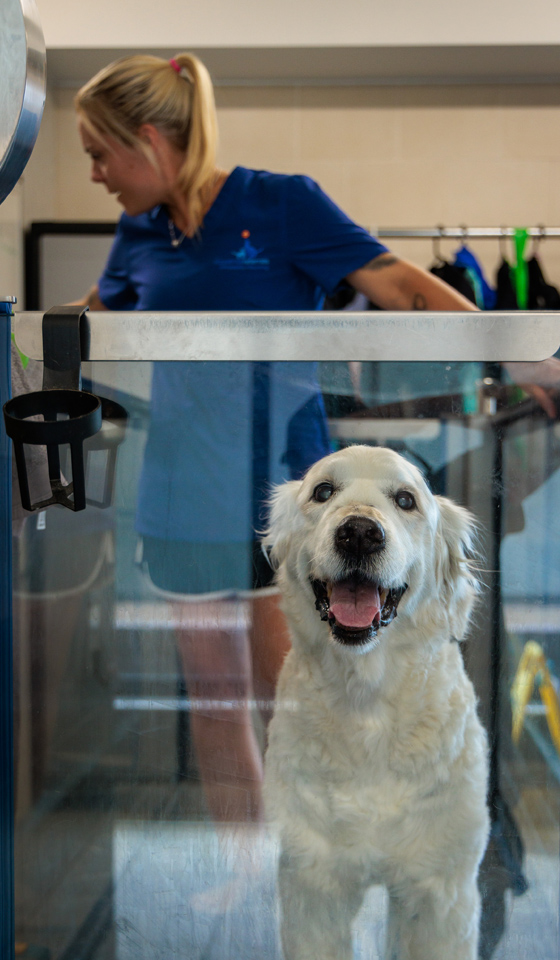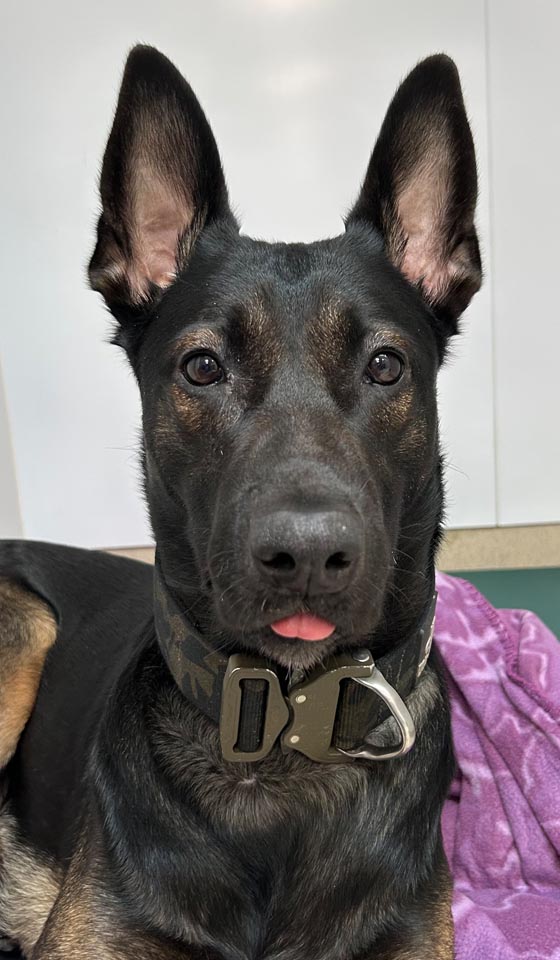The endoprosthesis completely replaces the section of bone affected by cancer and bridges the gap between the top and bottom of the dog’s leg to allow near normal use of the limb.
The most common bone tumour in dogs is an osteosarcoma
Sadly, bone tumours are quite common in dogs, the most common being an osteosarcoma. Bone tumours most frequently affect older, large and giant breed dogs, although middle-aged dogs can also be affected. Bone tumours are infrequently diagnosed in young dogs. Most owners first notice a mass forming on the leg or their dog limping. Some dogs experience sudden pathological fracture of a bone when they have been exercising vigorously. Although bone tumours can involve the forelimbs or hind limbs, certain sites may predominate, such as the lower forelimb (distal radius). If you suspect your dog might have a bone tumour then you should take him/her to see your local primary care vet.
How are bone tumours diagnosed?
In most cases, after a clinical examination and discussion, your vet will recommend taking a radiograph of the affected leg and other areas including the chest and abdomen. In almost all cases, radiographic changes consistent with a bone tumour alongside clinical presentation are enough to be confident of the diagnosis of a bone tumour. There are other disease processes that present in a similar way, such as fungal bone infections, but they are extremely rare in the UK. In the case of a pathological fracture, your vet will again suggest taking radiographs, but sometimes interpretation of the radiograph can be challenging. Your vet and possibly an orthopaedic specialist will need to carefully assess the radiographs to determine whether or not the fracture occurred because of a bone tumour or a less sinister reason.
Once a diagnosis of bone tumour has been reached, the next step is to “stage” the tumour, which tells us how advanced it is and helps guide treatment recommendations and prognosis. Staging involves a total body search for evidence of tumour outside of the primary site such as in the lungs, abdomen or other bones. This process can include, but is not limited to; blood tests, further radiographs, ultrasound scans, CT scans and MRI scans. A good number of dogs have no detectable evidence of tumour elsewhere in their body, although undetectable, microscopic levels are always present.
Although we can be confident in the diagnosis of a bone tumour, the exact tumour type can only be diagnosed once the tumour is removed and sent to a laboratory.
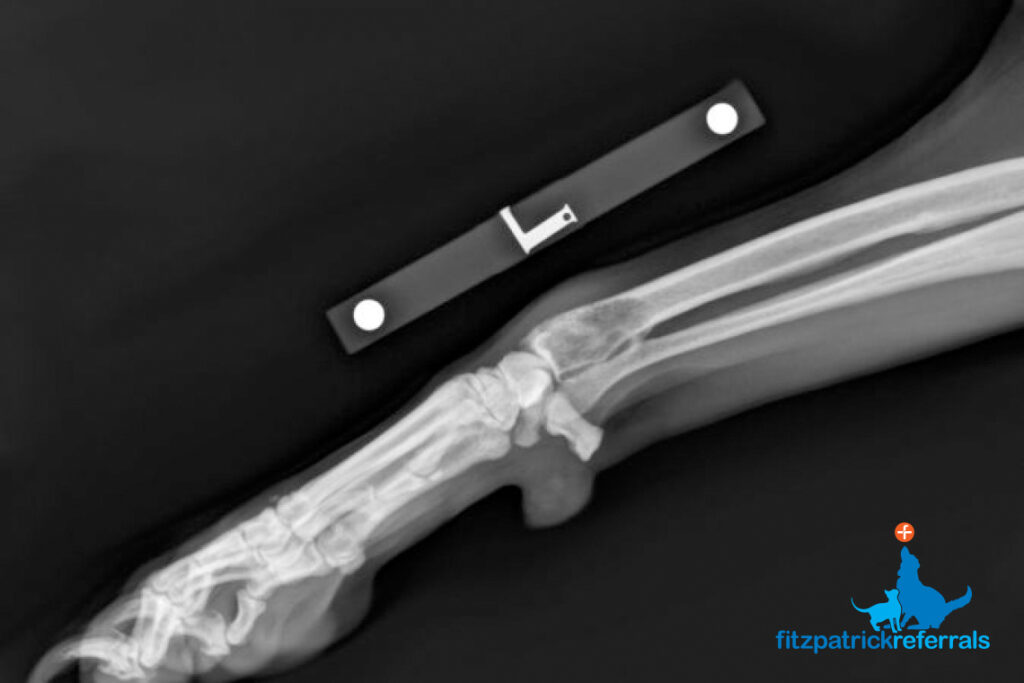
What is the prognosis for dogs diagnosed with bone tumours?
The prognosis of a dog with a bone tumour depends on the exact type of tumour, though they are most commonly an osteosarcoma. In dogs affected by osteosarcoma, prognosis depends on the stage of the disease and how it is managed. Surgical removal of the bone tumour without chemotherapy results in short median survival times (4-5 months). Equally, dogs that are found to have an advanced stage of disease where there is spread to other areas at the time of diagnosis are likely to have similarly short survival times.
For dogs with no spread of the tumour at the time of diagnosis who undergo surgery and chemotherapy, survival times are longer. Commonly, these dogs survive a median of 10-12 months, but some can survive a lot longer. Other tumour types have different survival times and some don’t require chemotherapy at all. More information on canine osteosarcoma.
Although we can be confident in the diagnosis of a bone tumour, the exact tumour type can only be diagnosed once the tumour is removed and sent to a laboratory.
What is a radial endoprosthesis?
In the forelimb, the area most commonly affected by a bone tumour is the distal (bottom portion) of the radius (one of the two bones that make up the forearm) nearest the carpus (wrist). The endoprosthesis completely replaces the section of bone containing the tumour and bridges the gap between the top and bottom of the dog’s leg to allow normal weight bearing.
The implant was designed by Professor Noel Fitzpatrick and has been developed over a number of years, improving each time. For a number of years, thanks to a lot of hard work and experience, we have been able to perform this surgery on the same day that we see your pet as standardised but customisable sizes have been developed, suitable for medium to giant dogs. This means there is no need to wait weeks for an implant to be designed and manufactured, which should ultimately improve the prognosis for your pet. We use special metal coatings and unique manufacturing techniques which allow the patient’s bone to physically grow onto the implant itself, creating a permanent bond between metal and bone. We have used this technology for the management of bone cancer in dogs with great success over several years. Typically, patients will use the limb comfortably within a few days after surgery and return to a near normal exercise routine after the recovery period.
Immediate postoperative radiograph of radial endoprosthesis in the left forelimb:
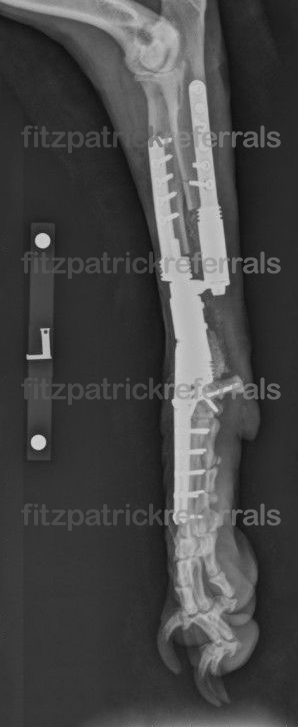
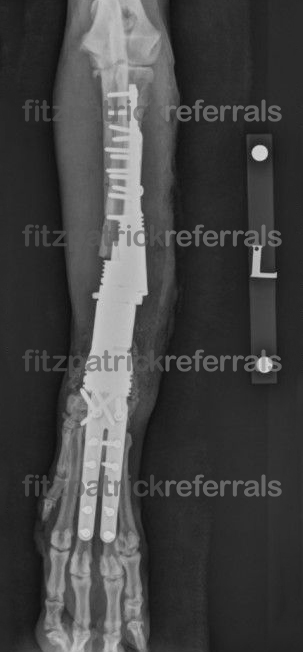
Three years following surgery. The patient’s own bone has grown onto the radial endoprosthesis:
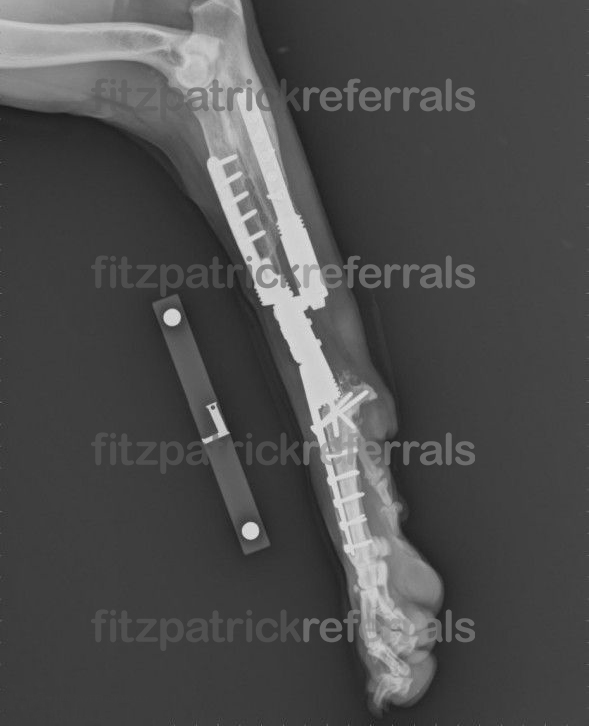
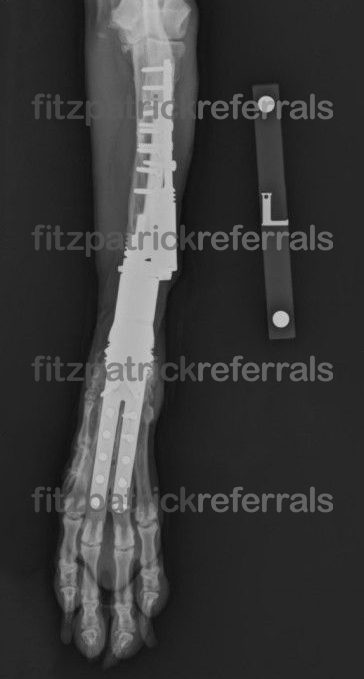
What is the typical recovery time after radial endoprosthesis?
During your dog’s hospital stay, they will be cared for by a dedicated team of ward nurses and ward auxiliaries who work alongside your dog’s clinician, a team of veterinary surgeons and chartered physiotherapists ensuring all your dog’s clinical and emotional needs are met. We expect dogs recovering from radial endoprosthesis surgery to be hospitalised for 5-7 days. Our priorities are that your dog is kept comfortable, that postoperatively swelling is well controlled and that they are able to confidently walk around with little physical support. The patient care team make sure your dog feels at home and treats them just as if your dog belonged to them, with the love and affection they desire and deserve.
Once home, your dog will need to be strictly crate rested for 6 weeks and will be allowed short lead walks to prevent damage to themselves or the new implant. Between 6 and 12 weeks postoperatively careful rehabilitation will be introduced and your dog will enjoy more freedom with longer lead walks. At 12 weeks postoperatively we hope that your pet will be able to enjoy normal daily life with unlimited off-lead exercise.
What are the risks of limb sparing surgery?
The main risks associated with limb sparing surgery are implant failure, infection and local or distant reoccurrence of the cancer. Careful postoperative management will reduce the risk of early implant failure and with new generation implants, implant breakage is rare. We aim to prevent infection by adhering to strict postoperative management protocols during the recovery phase. To help prevent reoccurrence of cancer we use postoperative chemotherapy to increase postoperative survival times.
Can my dog enjoy a normal lifestyle after radial endoprosthesis surgery?
The vast majority of dogs can return to normal exercise activities following the recovery period and enjoy the lifestyle they had before surgery. Your dog will require regular rechecks so we can make sure they continue to do well and will have to complete their course of chemotherapy prescribed by your oncology clinician
Are there reasons why my pet should not have limb sparing surgery?
We will not carry out limb sparing surgery if there is any evidence of metastatic disease (tumour spread) affecting the lungs or other bones, as mean survival time is not considered sufficient at this advanced stage to justify surgical intervention, in our view. Full limb amputation may still be considered in certain circumstances. Every patient is assessed on a completely individual basis and, rarely, there are situations where we would consider full limb amputation to be the best options instead of a limb sparing surgery. Our goal is to always act in the best interests of each and every patient to provide optimal pain-free functional quality of life.
What should I do if I think my pet has a condition that would benefit from a limb sparing procedure?
If you think your pet could benefit from a limb sparing procedure we recommend asking your veterinary surgeon to contact us for further advice. Vets may email [email protected] or call us on 01483 423761. We are more than happy to talk to your vet about what is involved with the surgery and ascertain if limb sparing surgery could help your pet.
QUESTIONS
FAQs
Here is a list of the common questions we receive at Fitzpatrick Referrals – if your question is not answered here, please contact us with your query and we will be happy to help!
What chemotherapy will my dog need and what does it involve?
Different chemotherapy drugs are given depending on the type of tumour. In dogs with osteosarcoma, it is likely that they will receive a drug called carboplatin, which is given intravenously over 30 minutes for a minimum of five sessions every three weeks as an outpatient service.
Whenever possible we place a Vascular Access Port (VAP), which are devices commonly used in human oncology. These are metal disks placed beneath the skin with an exit tube directly into a blood vessel. The disk can stay beneath the skin for months or years if necessary. This allows animals to receive chemotherapy drugs in a more relaxed setting without having to be as restrained or have their legs shaved or catheterised. When repeat catheterisation is required, a calm and well-behaved dog can receive these drugs safely without sedation, but dogs who are easily stressed in a hospital environment are usually given a light sedation so that the chemotherapy can be administered safely and the dog isn’t unnecessarily stressed.
A specialist chemotherapy nurse will explain the necessary health and safety to adhere to and side effects to be aware of whilst your dog is on chemotherapy.
Will chemotherapy make my dog sick?
Chemotherapy medications are used differently in the dog compared to their use in humans to best balance the need for relief of bone pain, establishment of a good quality of life and longevity. Chemotherapy medications in dogs are not associated with hair loss, but can cause some transient nausea, inappetence or loose stools for a day or so afterwards. Dogs will need to have blood tests a few days prior to each chemotherapy session to ensure that they are fit and well enough to receive the treatment.
Is the bionic leg implant (PerFiTS) used for the treatment of bone cancers?
An endoprosthesis would be our first limb sparing option for animals with bone tumours, however, a PerFiTS implant is sometimes required. The PerFiTS implant is usually more appropriate for soft tissue tumour affecting the limb, alongside deformities and trauma incidents. Read more about the PerFiTS.
9 minute read
In this article
